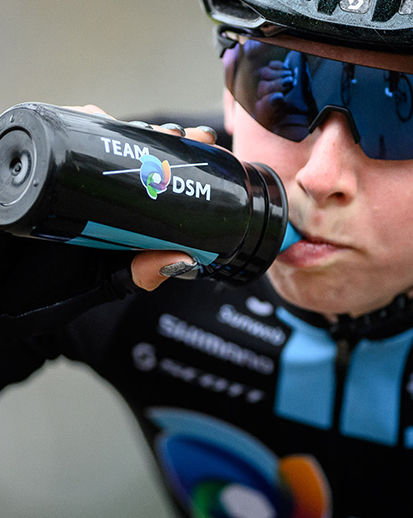Climate & Energy
In 2015, the Paris Agreement first established a common ambition to take urgent action on GHG emissions to limit average temperature increases to well below 2°C. Later in 2018, the Intergovernmental Panel on Climate Change (IPCC) provided a clear and compelling case to redouble efforts to limit the warming to 1.5°C. Our fair share of this ambition requires our emissions to reach net-zero by 2050 with a rapid acceleration of our rate of emission reductions over the coming decade. These are defined by our net-zero commitment and Science Based Targets.
|
|
Aspiration |
|
2020 |
|
2019 |
||||
|
|
|
|
|
|
|
||||
Greenhouse gas (GHG)1 |
|
|
|
|
|
|
||||
GHG emissions scope 1 + 2 absolute reduction versus 2016 |
|
30% in 2030 |
|
25% |
|
25% |
||||
GHG emissions scope 1 + 2 estimated structural improvement versus 2016 |
|
|
|
approx. 18% |
|
approx. 17% |
||||
GHG emissions scope 3 intensity reduction |
|
28% by 2030 |
|
5% |
|
- |
||||
GHG emissions scope 1 + 2 market-based (million tons) |
|
|
|
1.24 |
|
1.17 |
||||
GHG emissions scope 3 (million tons) |
|
|
|
12.0 |
|
11.6 |
||||
|
|
|
|
|
|
|
||||
Energy |
|
|
|
|
|
|
||||
Primary energy use (PJ) |
|
|
|
21.5 |
|
21.2 |
||||
Final consumed energy (PJ) |
|
|
|
18.2 |
|
17.4 |
||||
Energy efficiency improvement year-on-year |
|
> 1% |
|
5.7% |
|
2.3% |
||||
Purchased electricity from renewable sources |
|
75% by 2030 |
|
60% |
|
50% |
||||
|
||||||||||
Aligning our climate approach with science
We were one of the first companies to align our efforts with the latest science as presented in the IPCC Special Report ‘Global Warming of 1.5°C’ by setting a long-term pathway to reach net-zero GHG emissions across our operations and value chains by 2050. Our Science Based Targets are our foundation to achieve this goal, supported by our ambitions on renewable electricity and energy efficiency, and working intensively with our key suppliers through our CO2REDUCE program. Throughout 2020 and continuing into 2021, we are working with long-term innovation roadmaps to map pathways toward net-zero emissions in the coming decades.
As a complement to our efforts on climate change mitigation, we also work on an integrated strategy of climate adaptation measures to improve the resilience of our assets and supply chains against potential physical impacts of climate change.
“DSM is leading by example. We were one of the first companies in our industry to commit to net zero emissions by 2050, as well as defining the pathway to firmly set us on this course. Our Science Based Targets define our important mid-term step for 2030. I am immensely proud of the fast progress against our targets. We also continue to challenge, support and innovate with suppliers and customers to reduce their climate impact."Dimitri de Vreeze
Business measures supporting our climate approach
In support of our ambition to substantially reduce our carbon footprint, we have introduced key measures which we apply to all growth projects. Since 2019, business growth projects must either be GHG-neutral or else be compensated for within the same business.
In addition, to encourage investments in low-carbon and carbon-free technologies, we use an internal carbon price of €50/t CO2eq in the valuations of key investment projects and in the Profit and Loss statements of the business groups for internal management reporting. This increases the visibility of, and encourages accountability for, the impact of carbon on the business.
Ownership of climate actions is at Executive Committee level
The DSM climate action agenda brings together our key climate actions addressing the three pillars of improve, enable and advocate. The progress of the agenda, including the implementation of the Taskforce on Climate-related Disclosures (TCFD) recommendations, the GHG reduction program, our portfolio developments and efforts to advocate for accelerated transition with partners, are managed and actively reviewed by the Executive Committee several times a year.
Concrete actions within the agenda are owned by individual Executive Committee members. Through the agenda, we ensure that the business opportunities related to mitigation and adaptation, and the identified transition and physical risks of climate change are addressed. Our climate change strategy received an A rating from CDP in 2020.
“CDP awarded DSM Leadership status and an A score for its CDP climate change disclosure. This places DSM in the top 8% of participating companies in Europe. Companies reaching the Leadership level represent best practice through their comprehensive disclosure of environmental data, thorough awareness of risks, demonstration of strong governance and management of those risks, and implementation of market-leading best practices.”Maxfield Weiss
Primary energy is energy that has not yet been subjected to a human engineered conversion process. It is the energy contained in unprocessed fuels.
Final (consumed) energy is the energy that is consumed by end-users. The difference between primary energy and final consumed energy is caused by the conversion process between the two as well as any transmission losses.







